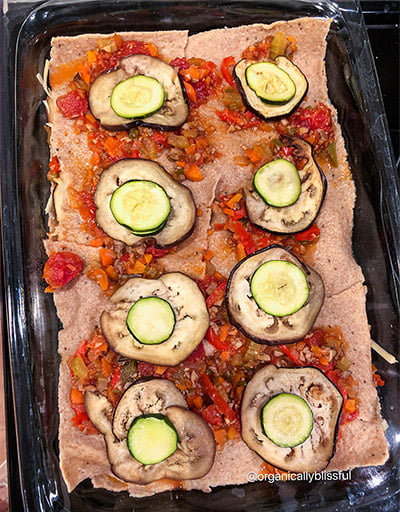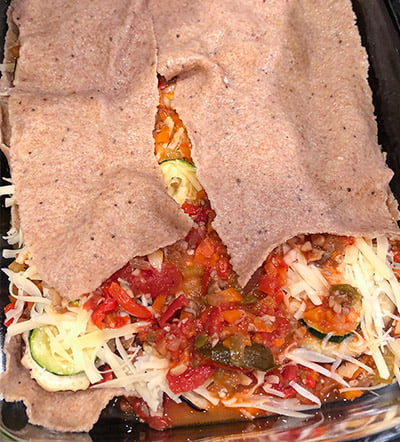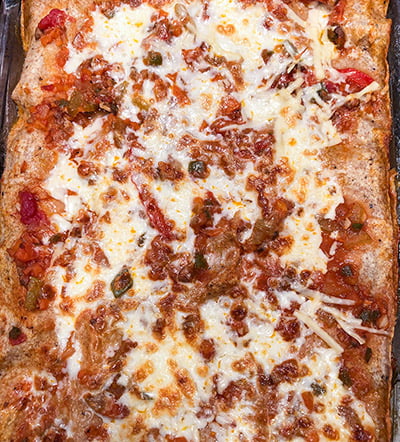
There's something truly irresistible about a steaming hot lasagna fresh out of the oven, with its layers of rich, flavorful ingredients and melted cheese. Traditionally a meat lover's paradise, lasagna has undergone a delightful transformation in recent years to accommodate the growing popularity of vegetarian and plant-based lifestyles. Enter the whole wheat veggie lasagna — a culinary masterpiece that brings together vibrant vegetables, luscious sauces, and tantalizing flavors, all nestled between tender lasagna noodles.
Whether you're a seasoned vegetarian, a curious flexitarian, or simply looking to explore new culinary horizons, making a vegetarian lasagna is an adventure you won't want to miss. Bursting with colors, textures, and a medley of flavors, this vegetarian delight promises to tantalize your taste buds and leave you craving more.
In this blog post, we will share how to make vegetable lasagna. With our veggie lasagna recipe, it will impress your family and friends, even the most ardent meat-eaters among them. We'll explore an array of fresh vegetables, indulgent cheeses, and aromatic herbs that will transform this classic Italian dish into a vegetarian masterpiece.
Best Vegetable Lasagna Recipe
Prep Time
20 minutes
Cook Time
50 minutes
Rest Time
30 minutes
Total Time
1 hour and 40 minutes
Ingredients
Sauce
Directions
Whole Wheat Lasagna Noodle
1. To begin, preheat your oven to 375°F (190°C). Follow the package instructions to cook the whole wheat lasagna noodles until they reach the desired al dente texture. Once cooked, drain the noodles and set them aside.

2. Using a large skillet, heat the olive oil over medium heat. Proceed by adding the diced onion and minced garlic, then sauté them until they become fragrant and slightly softened, typically taking around 3-4 minutes.
3. Introduce the sliced zucchini, diced red and yellow bell peppers, as well as the sliced mushrooms to the skillet. Cook for another 5-6 minutes, stirring occasionally, until the vegetables are tender.
4. Stir in the baby spinach and cook for an additional 2-3 minutes until the spinach wilts. Remove the skillet from heat.
5. Using a separate bowl, blend together the marinara sauce, crushed tomatoes, dried basil, dried oregano, salt, and black pepper. Ensure thorough mixing for a well-combined mixture.
6. Evenly distribute a thin layer of the sauce mixture on the bottom of a baking dish measuring 9x13 inches. Arrange 4 lasagna noodles over the sauce, slightly overlapping them.
7. Evenly distribute half of the ricotta cheese over the noodles, ensuring complete coverage. Next, layer half of the vegetable mixture on top, followed by a layer of sauce. Sprinkle half of the mozzarella and Parmesan cheese over the sauce to complete the layering process.
8. Repeat the layers: lasagna noodles, ricotta cheese, vegetable mixture, sauce, and cheese.
9. For the final layer, arrange the lasagna noodles on top and generously cover them with the remaining sauce and cheese.

10. After covering the baking dish with aluminum foil, place it in the preheated oven and bake for 25 minutes. Subsequently, remove the foil and continue baking for an additional 10-15 minutes, or until the cheese turns golden and starts to bubble.
11. Once the vegetable lasagna is done baking, take it out of the oven and allow it to cool for about 10-15 minutes before serving. Optionally, you can garnish it with fresh basil leaves for added flavor and presentation.

12. Slice and serve your wholesome whole wheat vegetable lasagna, and enjoy the delicious harmony of flavors and textures that this nutritious dish offers.
Tips & Notes
Pre Cook vegetables slightly: To ensure that your veggies are cooked to perfection in the vegetable lasagna, consider lightly sautéing or blanching them before layering. This will help retain their vibrant colors and prevent them from releasing excess moisture during baking.
Choose a quality marinara sauce: Select a high-quality marinara sauce or make your own from scratch using ripe tomatoes, herbs, and spices. A good sauce will elevate the overall taste of your vegetable lasagna.
Add fresh herbs: Enhance the flavor profile of your vegetable lasagna by incorporating fresh herbs like basil, parsley, or thyme. Finely chop the herbs and sprinkle them over each layer or add them to the sauce for a burst of freshness.
Nutritional Facts
Nutrition Facts
Servings: 8
Calories
478
% Daily Value*
Total Fat 14.9g
19%
Saturated Fat 6.1g
30%
Cholesterol 30mg
10%
Sodium 833mg
36%
Total Carbohydrate 59.9g
22%
Dietary Fiber 11.5g
41%
Total Sugars 13.1g
Protein 24.5g
Vitamin D 32mcg
158%
Calcium 352mg
27%
Iron 5mg
29%
Potassium 658mg
14%
*The % Daily Value (DV) tells you how much a nutrient in a food serving contributes to a daily diet. 2,000 calorie a day is used for general nutrition advice.
Let it rest: After baking, it is recommended to allow the vegetable lasagna to rest for approximately 10-15 minutes. This resting period aids in setting the layers, making it easier to cut and serve. Moreover, it allows the flavors to harmonize, resulting in a more cohesive and delectable dish.
Make-ahead and freezing options: You can prepare the vegetable lasagna ahead of time and refrigerate it overnight, allowing the flavors to develop further. Alternatively, you can assemble the vegetable lasagna and freeze it for future use. It is important to keep in mind that you should thaw the lasagna in the refrigerator prior to baking.
What You Will Need To Make Whole Wheat Vegetable Lasagna
Whole wheat lasagna noodles
Whole wheat noodles are made from whole grain flour, retaining the bran and germ. Whole wheat noodles offer a healthier alternative to refined flour noodles, as they are rich in fiber. This fiber content promotes digestion and assists in maintaining stable blood sugar levels. If whole wheat noodles are not available, you can use regular lasagna noodles or opt for gluten-free alternatives if needed.
Olive oil
Olive oil, a key ingredient in Mediterranean cuisine, adds a unique flavor profile to the dish. Notably, it contains monounsaturated fats that are beneficial for heart health, potentially reducing inflammation and lowering the risk of heart disease. If desired, you have the option to substitute olive oil with vegetable oil or other neutral-flavored oils for sautéing purposes.
Onion
Diced onions contribute a savory and subtly sweet taste to the vegetable lasagna, enhancing its overall flavor profile. These onions are not only flavorful but also packed with antioxidants and flavonoids, which have been linked to several health advantages, such as a lowered risk of heart disease and certain types of cancer. If preferred, shallots can be used as an alternative to onions in the recipe.
Garlic
In addition to providing a pungent and aromatic taste to the dish, garlic also presents potential health advantages. It possesses antimicrobial properties, boosts the immune system, and has the potential to lower cholesterol levels. In the absence of fresh garlic, you can substitute it with garlic powder or granulated garlic to achieve a similar flavor profile.
Zucchinis
Zucchinis bring a delicate texture and subtle sweetness to the vegetable lasagna. They are low in calories and high in fiber, vitamins (such as vitamin C and vitamin A), and minerals like potassium. If zucchinis are not your preference, you can substitute them with yellow squash or even eggplant for a similar texture and taste.
Red and yellow bell peppers
Diced bell peppers add vibrant colors and a mildly sweet taste to the vegetable lasagna. They are excellent sources of vitamin C, which supports immune health, and provide dietary fiber and antioxidants. If red or yellow bell peppers are not available, you can use green bell peppers as a substitute.
Mushrooms
The inclusion of sliced mushrooms in the vegetable lasagna brings a meaty texture and adds a delightful umami flavor to the dish. These mushrooms are not only low in calories but also free of fat, making them a healthy choice. Additionally, they are rich in B vitamins, selenium, and potassium, providing valuable nutrients to the overall meal.
Baby spinach
Baby spinach adds a burst of green color and a mild earthy taste to the lasagna. It is packed with iron, vitamins A and K, folate, and antioxidants. If you have a preference, Swiss chard or kale can be used as alternatives to baby spinach.
Marinara sauce
Marinara sauce serves as the base sauce in the lasagna, providing a rich tomato flavor. Look for a high-quality marinara sauce with minimal added sugars and preservatives. As an alternative, you have the option to prepare your own tomato sauce from fresh tomatoes or utilize a pre-made tomato-based pasta sauce.
Crushed tomatoes
Crushed tomatoes add depth and texture to the sauce. They provide a notable amount of vitamin C, potassium, and the antioxidant lycopene, making them a beneficial source of these nutrients. If crushed tomatoes are not available, tomato puree or tomato passata can be used as substitutes.
Dried basil and oregano
Dried basil and oregano are essential dried herbs commonly used in Italian cuisine. They bring aromatic and savory flavors to the lasagna. These herbs are rich in antioxidants and may have anti-inflammatory properties. If fresh basil and oregano leaves are available, they can be used instead for a more vibrant flavor.
Salt and black pepper
These common seasonings enhance the overall taste of the lasagna by balancing flavors and adding a touch of seasoning.
Ricotta cheese
Ricotta cheese adds a creamy and slightly tangy element to the vegetable lasagna. It serves as a valuable source of protein, calcium, and phosphorus. Cottage cheese or goat cheese can be used as alternatives to ricotta if preferred.
Mozzarella cheese
Grated mozzarella cheese melts beautifully, creating a gooey and stretchy texture in the vegetable lasagna. It provides a significant amount of protein and calcium, making it a beneficial source of these nutrients. Other types of melting cheese, like provolone or cheddar, can be used as substitutes.
Parmesan cheese
Grated Parmesan cheese contributes a delightful nutty and savory taste to the dish. It is rich in calcium and protein. Grana Padano or Pecorino Romano can be used as substitutes for Parmesan cheese.
Fresh basil leaves (optional)
To enhance the final dish with a burst of freshness and a subtle herbal note, you can use fresh basil leaves as a garnish.
How To Elevate This Vegetable Lasagna Recipe
Roasted vegetables
For a delightful twist, consider roasting the vegetables rather than sautéing them before incorporating them into the vegetable lasagna. Roasting enhances the vegetables' natural sweetness and intensifies their flavors. Simply toss the sliced zucchini, bell peppers, and mushrooms with olive oil, salt, and pepper, then roast them in the oven until they reach a tender and slightly caramelized state.
Homemade tomato sauce
Take the marinara sauce to another level by making it from scratch using fresh tomatoes, garlic, onions, and herbs. Simmer the ingredients together to create a rich and flavorful tomato sauce. This extra step will add depth and freshness to the vegetable lasagna.
Layered pesto
Add an extra layer of flavor by spreading a thin layer of homemade pesto sauce between the vegetable and cheese layers. Basil pesto or sun-dried tomato pesto works wonderfully in adding an herby and tangy note to the vegetable lasagna.
Seasoned ricotta mixture
Enhance the ricotta cheese layer by adding additional flavors. Mix in some freshly chopped herbs like basil, parsley, or thyme, along with minced garlic and a pinch of red pepper flakes. This seasoned ricotta cheese mixture filling will bring extra dimension and taste to the lasagna.
Experiment with cheeses
Explore different cheese combinations to elevate the flavor profile. Try using a mix of cheeses such as fontina, Gruyère, or smoked mozzarella along with traditional mozzarella and Parmesan. The blend of different cheeses will add complexity and richness to the dish.
Fresh tomato slices
Layer thin slices of fresh tomatoes between the vegetable layers for added freshness and a burst of juiciness. This adds a delightful contrast in texture and flavor to the lasagna.
Béchamel sauce
Consider adding a layer of creamy béchamel sauce to the lasagna. This classic white sauce made from butter, flour, and milk creates a luscious and velvety texture. Alternate the layers of marinara sauce and béchamel sauce for a rich and indulgent twist.
Herbed breadcrumbs
Sprinkle a mixture of seasoned breadcrumbs and chopped fresh herbs on top of the final cheese layer. This adds a crunchy texture and an extra layer of flavor. Prior to use, toast the breadcrumbs in a skillet with a drizzle of olive oil or butter until they turn a golden brown color.
Grilled vegetables
For a smoky and charred flavor, grill the vegetables instead of sautéing or roasting them. This method imparts a unique taste and adds depth to the overall dish.
Garnish with fresh herbs and microgreens
Just before serving, garnish the lasagna with a generous sprinkle of freshly chopped herbs such as basil or parsley. Additionally, add a handful of microgreens or baby arugula on top to bring a vibrant and fresh element to the presentation.
How To Store Leftover Lasagna
If you anticipate consuming the leftover lasagna within a few days, it is advisable to store it in an airtight container or wrap it tightly with plastic wrap. Keep it refrigerated at a temperature below 40°F (4°C). When appropriately stored, vegetable lasagna can typically be refrigerated for approximately 3-4 days.
If you find yourself with a larger quantity of leftover vegetable lasagna or desire to store it for an extended period, freezing is an excellent choice. When frozen correctly, lasagna can maintain its quality for up to 3 months without notable loss.
Frequently Asked Questions (FAQ)
Can I use any vegetables in veggie lasagna?
Yes, you can use a variety of vegetables in a vegetable lasagna. Popular vegetables for vegetable lasagna recipes include zucchini, bell peppers, mushrooms, spinach, eggplant, and carrots. Feel free to unleash your creativity and incorporate your preferred vegetables or opt for those in season for a delightful twist.
Should I cook the vegetables before layering them in the lasagna?
It's generally recommended to pre cook the vegetables slightly before layering them in the lasagna. Sautéing or blanching the vegetables helps enhance their flavors, soften them, and remove excess moisture, ensuring they cook evenly in the lasagna.
Can veggie lasagna be frozen?
Yes, veggie lasagna can be frozen. You have the option to assemble the lasagna, ensuring it is well-covered with foil or plastic wrap, and freeze it. Remember to thaw it in the refrigerator before proceeding with the baking process. Adjust the baking time accordingly, as a frozen lasagna will take longer to heat through.
Can I substitute ricotta cheese with another type of cheese?
Yes, you can substitute ricotta cheese with cottage cheese, goat cheese, or even a plant-based cheese alternative if you prefer. Each type of cheese will contribute its own distinct flavor and texture to the lasagna, creating a delightful variety in taste and mouthfeel.
How do I prevent the lasagna from becoming watery?
To prevent a watery vegetable lasagna, make sure to cook the vegetables thoroughly to remove excess moisture. You can also lightly sprinkle salt over the vegetables and let them sit for a few minutes to draw out moisture before layering. Additionally, using whole wheat lasagna noodles, no-boil lasagna noodles, or oven-ready noodles can help absorb some of the excess liquid.
